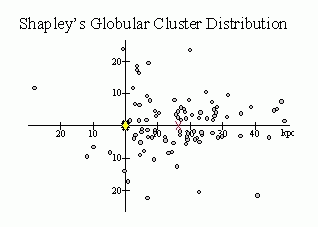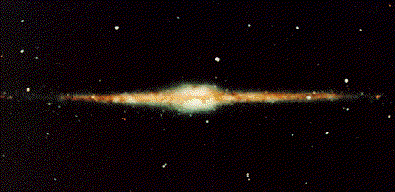
Unfortunately, Herschel didn't know that dust obscures our view of distant stars. Contrary to Herschel's belief, the Sun is not close to the center of our galaxy.
When Galileo turned his telescope on the Milky Way, early in the 17th century, he found it was made of many, many faint stars, each of them individually too faint to be seen by the naked eye. Galileo's discovery led to the hypothesis that the Sun is embedded within a disk of stars. The Milky Way occurs where we look in the direction parallel to the faces of the disk; in this direction, we see more stars, and their light adds together to make the continuous band of light we call the Milky Way.
In the 18th century, William Herschel (discoverer of the planet
Uranus), with the assistance of his
sister Caroline (discoverer of many comets), made
the first attempt to determine accurately the shape of our
galaxy. He counted the number of stars visible in 683
lines of sight leading away from the Sun. If he saw few
stars, he concluded that the edge of the Galaxy was very
near in that direction. If he saw many stars, he concluded
that the edge of the Galaxy was far away. The grand conclusion:
the galaxy is shaped like an irregular ``grindstone''. (The
stones used to grind wheat in the 18th century were shaped
like giant hockey pucks.) A cross-section of our galaxy,
as plotted by Herschel, is shown below. The Sun is
slightly off-center to the left.

Unfortunately, Herschel didn't know that dust obscures
our view of distant stars. Contrary to Herschel's belief,
the Sun is not close to the center of our galaxy.
A better attempt to determine the shape and size of our galaxy was made in the early 20th century, by an astronomer called Harlow Shapley. He was studying globular clusters (dense clusters containing hundreds of thousands of stars). There are a couple of hundred globular clusters in a spherical swarm surrounding our galaxy. If the Sun were at the center of our galaxy, we would see equal numbers of globular clusters in all directions. However, Shapley found that globular clusters all tend to lie on one side of the sky, in the direction of the constellation Sagittarius. Therefore, Shapley concluded, the center of our galaxy lies in the direction of Sagittarius.
Shapley was also able to measure the distances to globular
clusters. The clusters contained RR Lyrae variable stars.
Every RR Lyrae variable star (as described in the
lecture for Wednesday,
January 29) has a luminosity of about L = 80 Lsun.
By measuring the apparent brightness b of each RR Lyrae,
he could compute its distance from the relation L = 4 pi d2 b.
Shapley's plot of the distribution of globular clusters
is shown below. The red X to the right is the center of
our galaxy, as defined by the positions of the globular clusters.

Unfortunately, Shapley's distance measurements were too large
(he underestimated the dimming power of dust). The best current
estimate is that the Sun is 8000 parsecs (26,000 light years)
away from the center of our galaxy.
Astronomy has a way of deflating human egos; it's not
all about us.
Copernicus pointed out that the Earth is not at the
center of the Solar System - it's just one of nine planets.
Shapley pointed out that the Solar System is not at the
center of our galaxy - it's just one of 200 billion stars.
(In case you were wondering, our galaxy is not at the
center of the universe. In fact, there's no evidence to
indicate that the universe even has a center.)
At the center of our galaxy is a relatively small central
bulge. The bulge is about 2000 parsecs in
diameter. Some stars in the bulge are young population I
stars. Other stars are ``population II'' stars, meaning
that they are relatively old, and are poor in heavy elements,
having been created before the interstellar gas had been
seriously polluted with elements heavier than helium.
(The presence of the central bulge means that our galaxy
is not shaped like a hockey puck; it's more like a pair
of fried eggs placed back-to-back. A good view of the
central bulge of our galaxy is given by the infrared picture
below, which also shows the disk extending to either side.)

[Image credit: NASA & the Cosmic Background Explorer]
Surrounding both the disk and bulge is an enormous spherical halo. The halo is about 100,000 parsecs in diameter, twice the diameter of the disk. The stars in the halo are widely scattered, and are mostly very far from the Sun. (The Milky Way that we see in the sky is made of disk stars, not halo stars). The stars in the halo are all population II stars, very old and containing few heavy elements. The globular clusters surrounding our galaxy are part of the halo, and are very old, with ages greater than 10 billion years. (That is, in the globular clusters, all stars more massive than the Sun have evolved off the main sequence.)
The gas within the disk can be mapped. Conveniently, atomic hydrogen gas emits radio waves at a wavelength of 21 centimeters (about 8 inches). These radio waves are too long in wavelength to be absorbed by dust, so they provide an excellent way of peering through the dust that clutters up the disk. Intriguingly, maps of hydrogen gas reveal that the gas is not spread evenly throughout the disk, but is concentrated in a few spiral arms. (The Sun is located in the Orion arm.)
The spiral arms of our galaxy contain:
Because O and B stars are very luminous, spiral arms are
very prominent in snapshots of galaxies similar to our own.
For instance, the picture below is of a galaxy called
the Whirlpool Galaxy (also known by its catalog number of
M51). Note the two long, bright arms spiraling outward
from its bulge.

Prof. Barbara Ryden (ryden@astronomy.ohio-state.edu)
Updated: 2003 February 18
Copyright © 2003, Barbara Ryden